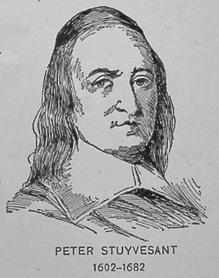This is an old revision of this page, as edited by 83.177.236.147 (talk) at 16:42, 13 March 2005 (fr). The present address (URL) is a permanent link to this revision, which may differ significantly from the current revision.
Revision as of 16:42, 13 March 2005 by 83.177.236.147 (talk) (fr)(diff) ← Previous revision | Latest revision (diff) | Newer revision → (diff)| It has been suggested that this article be merged with a page that has not been specified. If you are the editor who added this template, please specify. (Discuss) |

Petrus Stuyvesant (born 1611 or 1612, presumably in Peperga (Friesland), died 1672) served as the last Dutch director general of the colony of New Netherland before it was turned over to the English. He was a major figure in the early history of New York City.
Stuyvesant's accomplishment as director-general included a great expansion for the settlement of New Amsterdam (later renamed New York) beyond the southern tip of Manhattan. Among the projects built by Stuyvesant's administration were the protective wall on Wall Street, the canal which became Canal Street, and Broadway.
Stuyvesant and his family were large land owners in the northeastern portion of New Amsterdam, and the Stuyvesant name is currently associated with the Stuyvesant Town housing complex and Stuyvesant High School, among other locations. This farm, called the "Bouwerie" (the seventeenth-century Dutch word for farm, which was used for other farms in New Netherland as well) is the origin of the name Bowery and the chapel facing its long approach road (now Stuyvesant Street) developed into St Mark's in the Bowery. Stuyvesant's grand official residence at the very tip of Manhattan was renamed "Whitehall" by the English and survives in another New York street name.
As director-general Stuyvesant and his council took several measures concerning religion in New Netherland. Convinced that religious plurality would endanger the stability of the young colonial society, director general and council tried to restrict freedom of worship of several groups among the colonists, such as Jews, Lutherans, and Quakers. The directors of the West India Company of Amsterdam, Stuyvesant's superiors, overruled him, and mitigated some of the harsh measures that Director General and Council had taken. It is with great irony that in 1902 Stuyvesant High School in Manhattan, which was at the time of its founding a predominantly Jewish school for boys, was named after him.
Prior to his appointment as director-general, Stuyvesant served as a director for the Dutch West India Company in charge of the so-called 'abc islands' of Aruba, Bonaire and Curacao. He lost his leg in a battle with the Spanish over the island of Sint Maarten and wore a pegleg for most of his adult life.
A Dutch cigarette brand is named Peter Stuyvesant after him. These are popular in Australia, where they are known as 'Stuyvos'.
Categories: